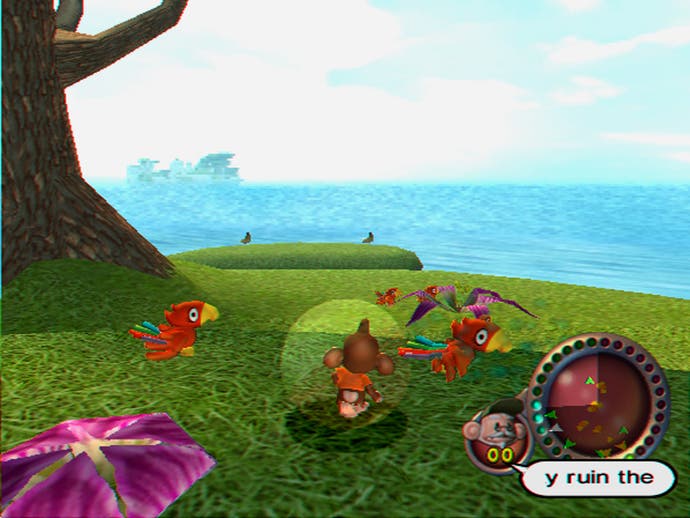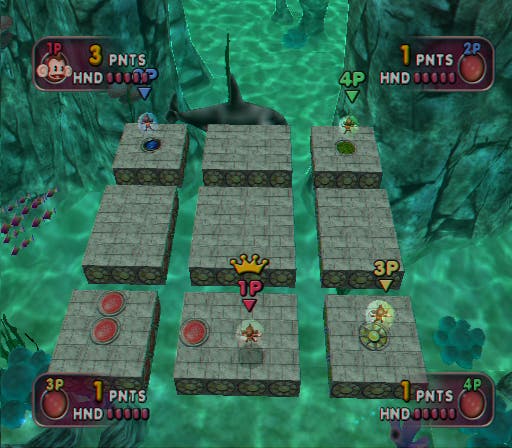Super Monkey Ball Adventure
Poo-Poo-Poo.
Reviewing Super Monkey Ball Adventure is a bit like buying the director's cut of a favourite film and realising that the director has nothing useful to add. At times - and I realise that I'm not so much throwing stones in my glasshouse here as putting a gravel driveway through a spin cycle and then kicking the door open - you really do appreciate it when something's enjoyed a good edit.
Monkey Ball's never really been about telling a story - but shoehorned into the traditional narrative structure of a platform game there's no escaping it, and here there's so much redundant waffling, and it's so far beyond saccharine that our teeth rot whenever we pick up the pad. The main thrust of it is that we're on a mission to criss-cross five monkey kingdoms delivering joy - not something with which the rest of the game's destined to be particularly synonymous.
Another thing about directors' cuts, of course, is that you already know precisely what's going to happen. SEGA would like to have us think that a platform game based on Super Monkey Ball is something new and exciting, but it's hard to imagine how it could be any less so - and equally hard to explain the set-up of running around five worlds, each populated with collectible bananas (some, gosh, hidden in crates), and an array of tasks at best loosely related to the old-days fetch-quest, without lapsing into sombre tones. Or SMBA tones, I suppose.

There are bounce pads, monkeys handing out quests, items/creatures/balloons/etc. to collect and deliver, and a range of special abilities that often draw upon the things that the monkeys-in-balls have previously gotten up to across three home-console games and a pair of handheld releases. So you can box, fly, single-handedly establish a Nintendo console amongst the hardcore, and so on (well, some of that), and each ability is activated by performing a sequence of pad directions that spells out the associated chant. For example, "Ei-Poo-Poo". Or "Poo-Woo-Ei". You might argue that that's a bit like Zelda: The Wind Waker, but you'd be reaching.
Anyway, as you navigate the five monkey kingdoms, rolling from task to task, your enthusiasm for the roadside bananas ticking over, these skills are gradually called upon. In, for the most part, boringly obvious ways.
But of course SMBA's failing is not that it's an indulgent director's preferred cut (indeed, series creator Amusement Vision had nothing to do with this; having set to work on a Nintendo Wii title, Traveller's Tales were sought to handle current-generation monkeys). It's that it doesn't really introduce anything new, and it doesn't really introduce it to a genre that certainly doesn't benefit from its lack of presence.
The controls are, apart from the addition of camera control to the right analogue stick, largely in line with deliberate physics of the classic Monkey Ball obstacle-course-in-the-sky routine. But with what feels like a bit more friction beneath the ball and less excuse for a disobedient camera, you might as well be playing any other 3D platform game - and while it's handy to be able to turn off the world-tilting elements of the original games' camera, not being able to invert camera control on either axis or adjust sensitivity is a bafflingly obvious oversight.

Add to this a peculiar checkpoint system, which happily drops you off a few seconds back but occasionally deposits you a whole section back depending on how many times you've fallen into the world-surrounding water/abyss lately, and already it's starting to sound like a boring equation. And if we're doing a maths metaphor, the system of loading levels behind the scenes is all very well, but the decision to have the player manually crank a rotary load system is like taking away the calculator. It's clearly meant as a sort of interactive load screen; it feels more like you're manually turning the CD in the drive, and worryingly that fits rather well with the pace of the game overall, which ambles from task to task in the complete absence of challenge of gravitas for a good while (in the latter case, forever), before becoming tricky enough to put the squeeze on anything that was only slightly annoying.
The central Story mode's not without its moments though. But then Story mode's strengths are the things that it has in common with its predecessors; bouncing, flying, manoeuvring over tricky platforms, and, whenever you're on the brink of unlocking a new area, a series of actual puzzle trays. The reintroduction of game elements that SMBA is meant to transcend merely serves to reinforce the notion that it does not.
Fortunately, Traveller's Tales had the presence of mind to simply include all the old bits anyway, and in roughly the same format: a challenge mode, split into three difficulty levels, that tasks you with completing a series of puzzle trays using a limited number of lives; and a party games mode, which allows you and up to three friends to out-race, out-fly, out-punch and out-new-addition each other.
Challenge mode is fine, but its subordination means that we're limited to just 50 trays - although even the first few advanced levels will take a steely concentration, persistence and quick fingers to overcome.

As expected, the mini-games are the highlight. The most enduring three of the existing games return (race, target and flight) with new arenas, power-ups and ideas, and, like Super Monkey Ball 2, there isn't a whole lot wrong with the changes made but they remain at their best in their purest distillation. Meanwhile, the three newcomers involve a sort of bounce-pad noughts-and-crosses game that, rather like the pencil-and-paper game, quickly falls into obvious patterns; a race to collect balloons as they bobble across the surface of a miniature planet; and a sort of cannon-Jenga game of shooting holes in opposing players' forts.
As part of a better whole, the new party games might assume the same cultish status as something like Monkey Target - but the feeling I get is that nothing in SMBA is likely to be remembered all that long or with terrific fondness. Which is a shame, because apart from the rather boring Story mode, there's plenty of evidence that Traveller's Tales can be trusted with the core Monkey Ball concepts - and not merely sought for a low-budget sequel. The problem seems to be that everyone involved was aiming low, and it's not a game that ever speaks of large-scale effort or imagination; the graphics are recycled, the monkey voices are largely the same throughout, and the script is humourless, journeyman stuff that wouldn't make it onto CBeebies. There's no enthusiasm - and judging by the six pages accidentally headlined "Part Games" in the manual, it wasn't just the developers who laboured over it either.
In the end there's nothing damning enough to sink SMBA into the lower reaches of the scoring spectrum. But then, the only thing I can really think of to applaud is that it's a game about monkeys, in balls, who can fly, and have established a fledging democracy, and there's virtually nothing remarkable about any of it. Stick with Super Monkey Ball Deluxe instead.








